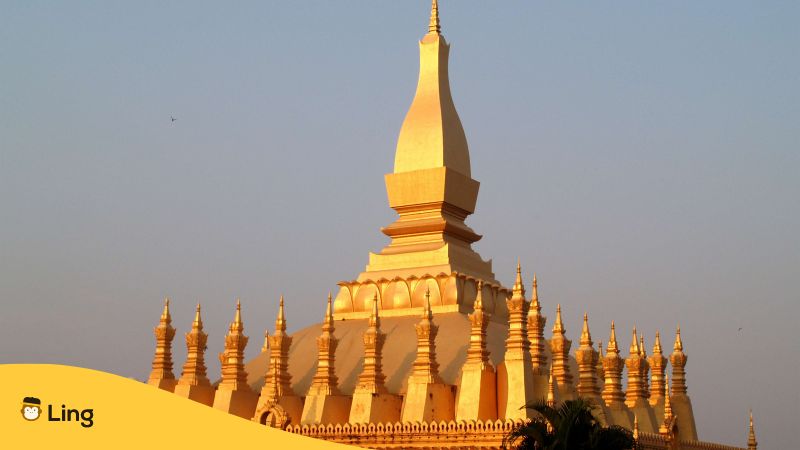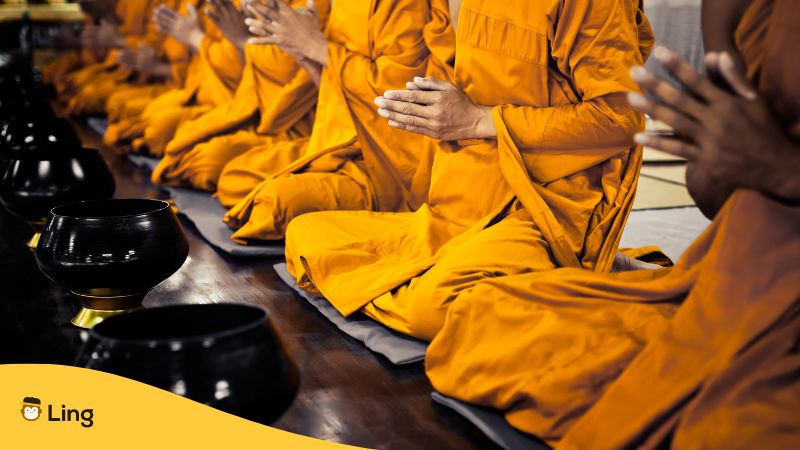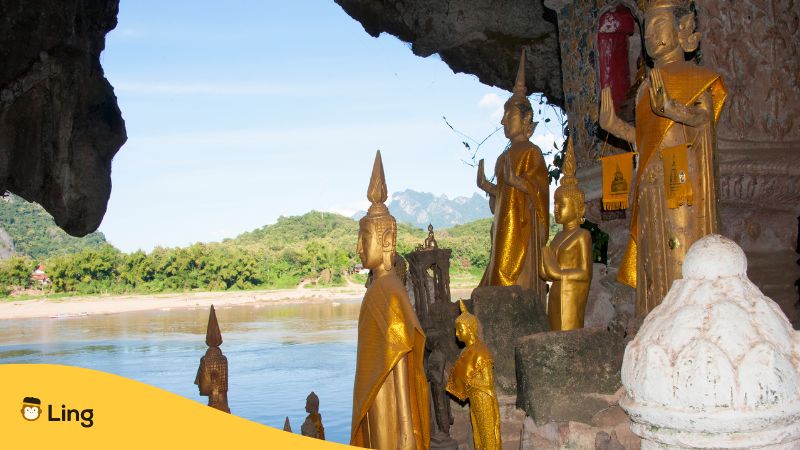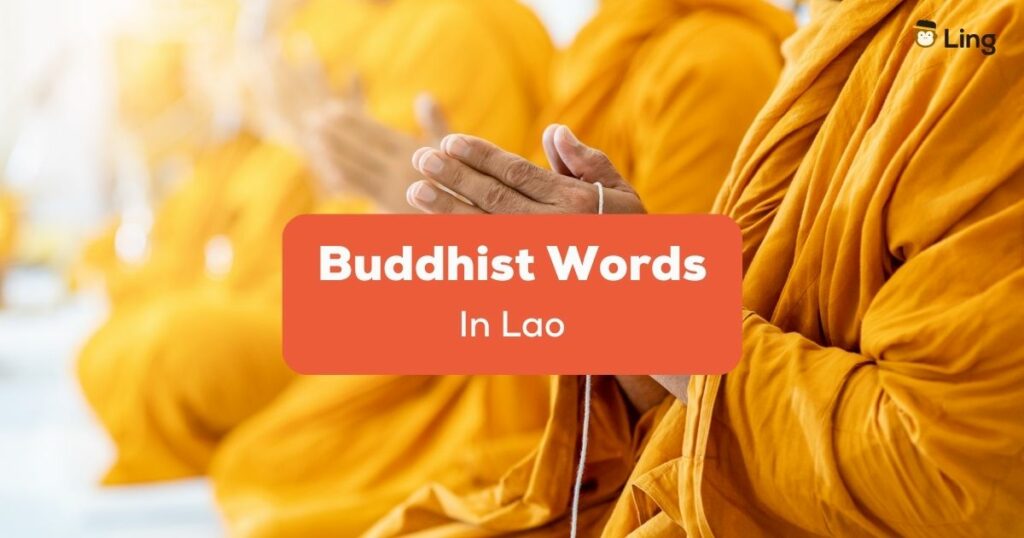Did you know about the sacred Pak Ou Caves that lie in the heart of Laos? Well, these aren’t some ordinary caves. They hold a hidden treasure of Buddhist artifacts within their bosoms. Yes, you read that right! These artifacts are, in fact, a veritable repository of Buddhist art and culture.
In fact, the Pha That Luang or Golden Stupa – a Buddhist stupa – is the national symbol of Laos, with stupa being one of the most popular Buddhist words in Lao. You see, Buddhism is the major, prevalent religion of Laos. So, it wouldn’t be an exaggeration to say that Buddhism gives Laos its distinct identity all across Southeast Asia.
So, in this blog, let’s explore the significance of Buddhism in Laos, and how Buddhist Lao words still hold relevance among the Lao people.

Buddhism In Laos
Buddhism entered the small and quaint kingdom of Laos around the 7th century CE, making its way from its birthplace in India. It was brought to this ‘land of elephants’ by the wandering Buddhist monks, who traveled through diverse landscapes in a bid to share and propagate their teachings.
On the other hand, Southern China – with its already established trade routes and cultural exchanges – also played a significant role in the southward expansion of Buddhism. As these monks ventured into Laos, they carried with them not just religious treatises and teachings, but also cultural elements that would gradually intertwine with the local ethos to give the Laotian society its current structure.
In fact, Buddhism adapted to the country’s unique cultural tapestry like a fish to water. One noteworthy aspect of this evolution was the integration of loan words from Pali and Sanskrit – the original language of the Buddhist texts – into the Lao language. Buddhist teachings were translated into the local language. This linguistic fusion allowed the Buddhist religion to make inroads into Laotian homes and seep into the daily lives of Laotians. The various religious, cultural, and social festivals celebrated today in Laos are long-living evidence of Buddhism’s longevity.
Over time, Buddhism became an integral part of Lao identity and daily life. The Buddhist monasteries were established, and they gradually started serving as centers of learning, meditation, and community gathering. The Sangha – the name given to a gathering or community of Buddhist monks by the Buddha himself – was tasked with the responsibility of upholding religious practices as well as playing the role of educator, administrator, and preserver of cultural heritage. In fact, Buddhism’s enduring presence in the country has been serving as the cornerstone of Laotian society for centuries now.

Buddhist Words In Lao
Now that we know how deeply enmeshed Buddhism is with the daily living of Laotians, let us look at some popular Buddhist words that are still part of the local parlance of the Lao society. Do note that Pali is a dead language, relegated only to the Pali Canon – a treatise of Buddhist scriptures.
| English | Pali | Lao |
|---|---|---|
| Buddha | Bodhisattva/ Buddha | Pha phudthachao |
| Buddhism | Baudha | Phudtha sasana |
| Buddhist History | – | Pavadsad phudtha sasana |
| Buddha Statue/ Image | – | Pha phudtha hub |
| Community | Sangha | Sumson |
| Religion | Dhamma | Sadsana |
| Monk | Bhikkhu | Phasong |
| Nun | Bhikkhuni | Phasong nying |
| Frangipani Flower | Campaka | Cham pā |
| Suffering | Dukkha | Khuaam osksao |
| Pleasure | Sukkha | khuaamsuk |
| Consciousness | Citta | Sati |
Interesting Trivia: Pak Ou Caves
Now, let’s loop back to the interesting trivia about the sacred Pak Ou caves. What makes them particularly fascinating is that they house thousands of small Buddha statues. These caves, located at the confluence of the Mekong and Nam Ou rivers near Luang Prabang, have been used as a spiritual site for centuries.
Now, according to the local legend, these statues were placed in the caves in the form of offerings made by devout Buddhists for many generations. Pilgrims, fishermen, and traders would bring these statues as tokens of devotion, creating a unique and awe-inspiring collection within the caves.
The Pak Ou Caves are divided into two sections. The lower cave, Tham Ting, and the upper cave, Tham Theung. The lower cave is relatively easy to access and displays a variety of Buddha images placed on well-lit shelves. The upper cave, on the other hand, requires a bit more effort to reach – one needs to climb up a steep set of stairs to access the upper station. This cave holds a much darker, more mysterious atmosphere and contains even more Buddha statues, some of which are quite old and weathered.
So, for a tourist, visiting the Pak Ou Caves is not only an opportunity to witness the intricate artwork and sculptures dedicated to Buddhism but also a chance to understand the depth of spiritual devotion that has persisted in this region for centuries. It’s a lesser-known aspect of Laos’s rich cultural heritage and its connection to Buddhism.

Learn Lao With Ling
Now that you know an interesting trivia about the exotic land of Laos, and the unique identity of the Lao language, why not discover some more similar gems? You can check them out on the Lao blog hosted by the Ling language learning platform.
In fact, you can take a step further and explore the Ling app – a gamified language learning app – for fun and engaging lessons on the Lao language. And while you are at it, don’t just stop at discovering Lao; you have the option to choose from more than 60 languages!
So, go to your Play Store or App Store and download the Ling app now!



































































